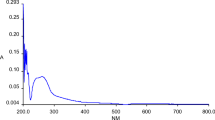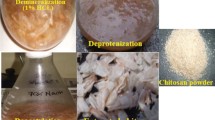Abstract
The aim of the present study was to characterize the chitosan synthesized from blue crab (Callinectes sapidus, Rathbun, 1986) shell waste and to investigate its physicochemical and microstructural analyses as well as its antioxidant and antibacterial potentials. Microstructural and elemental characterization of the synthesized and commercial chitosan powders were performed using fourier transform infra-red spectroscopy, scanning electron microscopy and energy dispersive X-ray spectroscopy. Thermal analysis were done using thermogravimetric analysis. Antioxidant and antimicrobial analysis were done using by DPPH (1,1-diphenyl-2-picrylhydrazyl) free radical scavenging assay and agar well diffusion assay, respectively. The yield of the synthesized chitosan was calculated as 7.47% with moisture and ash contents of 0.151 ± 0.0025% and 0.19 ± 0.01%, respectively. Synthesized chitosan demonstrated the values of degree of deacetylation (71%), water (620.029 ± 52.59%) and fat (437.93 ± 15.92%) binding capacities, solubility (94.15 ± 2.84%), viscosity (463.25 ± 13.10 cPs) and whiteness (90.23 ± 0.27%). Antioxidant activity of synthesized chitosan was found to be moderate (55.30 ± 5.05%) when compared to ascorbic acid standard (87.61 ± 1.34). Chitosan obtained from blue crab shell also showed moderate antibacterial activity against Staphylococcus aureus and Escherichia coli. The findings of the study indicated that blue crab shell waste might be a potentially effective biopolymer source for commercial applications especially in food industry.



Similar content being viewed by others
References
Mauricio-Sánchez RA, Salazar R, Luna-Bárcenas JG, Mendoza-Galván A (2018) FTIR spectroscopy studies on the spontaneous neutralization of chitosan acetate films by moisture conditioning. Vib Spectrosc 94:1–6
Sugiyanti D, Darmadji P, Anggrahini S, Anwar C, Santoso U (2018) Preparation and characterization of chitosan from Indonesian Tambak Lorok shrimp shell waste and crab shell waste. Pak J Nutr 17(9):446–453
Demir A, Seventekin N (2009) Chitin, chitosan and general application areas. Electron J Text Technol 3(2):92–103
Kumari S, Annamareddy SHK, Abanti S, Rath PK (2017) Physicochemical properties and characterization of chitosan synthesized from fish scales, crab and shrimp shells. Int J Biol Macromol 104:1697–1705
Özbay T, Baştürk Ö, Sungur MA (2012) The efficiency of chitin and chitosan of shell waste of Manta shrimp (Squilla sp.), squid (Sepia sp.) and blue crab (Callinectes sapidus, Rathbun, 1896). Yunus Res Bullet 12(1):13–19
Üçgül İ, Aras S, Özdemir Küçükçapraz D (2016) Purification of the chitin from different sources material and textile applications. Erzincan Univ J Sci Technol 9(1):46–56
Tharanathan RN, Kittur FS (2003) Chitin-the undisputed biomolecule of great potential. Crit Rev Food Sci Nutr 43:61–87
Demir D, Öfkeli F, Ceylan S, Bölgen Karagülle N (2016) Extraction and characterization of chitin and chitosan from blue crab and synthesis of chitosan cryogel scaffolds. J Turk Chem Soc, Sect A: Chem 3(3):131–144
AOAC (2006) Moisture of meat. Official methods of analysis of AOAC International. 18th ed. Method 950.46, Gaitherburg M.D
AOAC (2006a) Ash of meat. Official methods of analysis of AOAC International. 18th ed. Method 950.153, Gaitherburg M.D
CIE (1976) Commission Internationale de l'Eclairage. 18th session, CIE Publication 36, Paris, France
Seo S, King JM, Prinyawiwatkul W (2007) Simultaneous depolymerisation and decolorization of chitosan by ozone treatment. J Food Sci 72(9):522–526
Sarbon NM, Sandanamsamy S, Kamaruzaman SFS, Ahmad F (2015) Chitosan extracted from mud crab (Scylla olivicea) shells: physicochemical and antioxidant properties. J Food Sci Technol 52(7):4266–4275
Nessa F, Masum SM, Asaduzzaman M, Roy SK, Hossain MM, Jahan MS (2010) A Process for the preparation of chitin and chitosan from prawn shell waste. Bangladesh J Sci Ind Res 45(4):323–330
Khan TA, Peh KK, Ch’ng HS (2002) Reporting degree of deacetylation values of chitosan: the influence of analytical methods. J Pharm Pharmaceut Sci 5(3):205–212
Brand-Williams W, Cuvelier ME, Berset CLWT (1995) Use of a free radical method to evaluate antioxidant activity. LWT-Food Sci Technol 28(1):25–30
Mensor LL, Menezes FS, Leitão GG, Reis AS, Santos TCD, Coube CS, Leitão SG (2001) Screening of Brazilian plant extracts for antioxidant activity by the use of DPPH free radical method. Phytother Res 15(2):127–130
NCCLS (1993) Performance standards for antimicrobial disc suspectibility tests. Approved Standard NCCLS Publication M2-A5, Villanova, PA, USA
Hajji S, Younes I, Ghorbel-Bellaaj O, Hajji R, Rinaudo M, Nasri M, Jellouli K (2014) Structural differences between chitin and chitosan extracted from three different marine sources. Int J Biol Macromol 65:298–306
Hamdi M, Hajji S, Affes S, Taktak W, Maâlej H, Nasri M, Nasri R (2018) Development of a controlled bioconversion process for the recovery of chitosan from blue crab (Portunus segnis) exoskeleton. Food Hydrocol 77:534–548
Baron RD, Pérez LL, Salcedo JM, Córdoba LP, do Amaral Sobral PJ (2017) Production and characterization of films based on blends of chitosan from blue crab (Callinectes sapidus) waste and pectin from orange (Citrus sinensis Osbeck) peel. Int J Biol Macromol 98:676–683
Küçükgülmez A (2018) Extraction of chitin from crayfish (Astacus leptodactylus) shell waste. Alınteri J Agric Sci 33(1):99–104
Hossain MS, Iqbal A (2014) Production and characterization of chitosan from shrimp waste. J Bangladesh Agril Univ 12(1):153–160
Fernandez-Kim SO (2004) Physicochemical and functional properties of crawfish chitosan as affected by different processing protocols. BS, Seoul National University, LSU Master's Theses, p 53
Ocloo FCK, Quayson ET, Adu-Gyamfi A, Quarcoo EA, Asare D, Serfor-Armah Y, Woode BK (2011) Physicochemical and functional characteristics of radiation-processed shrimp chitosan. Radiat Phys Chem 80(7):837–841
Parthiban F, Balasundari S, Gopalakannan A, Rathnakumar K, Felix S (2017) Comparison of the quality of chitin and chitosan from shrimp, crab and squilla waste. Curr World Environ 12(3):672–679
Rodríguez-Núñez JR, Madera-Santana TJ, Sánchez-Machado DI, López-Cervantes J, Valdez HS (2014) Chitosan/hydrophilic plasticizer-based films: preparation, physicochemical and antimicrobial properties. J Polym Environ 22(1):41–51
No HK, Meyers SP (1995) Preparation and characterization of chitin and chitosan-a review. J Aquat Food Prod Technol 4(2):27–52
Nouri M, Khodaiyan F, Razavi SH, Mousavi MA (2016) The effect of different chemical and physical processing on the physicochemical and functional characterization of chitosan extracted from shrimp waste species of Indian white shrimp. Prog Rubber Plast Re 32(1):39–54
Potivas T, Laokuldilok T (2014) Deacetylation of chitin and the properties of chitosan films with various deacetylation degrees. CMU J Nat Sci 13(1):559–567
Yen MT, Yang JH, Mau JL (2009) Physicochemical characterization of chitin and chitosan from crab shells. Carbohydr Polym 75(1):15–21
Thakur VK, Thakur MK (2014) Recent advances in graft copolymerization and applications of chitosan: a review. ACS Sustain Chem Eng 2(12):2637–2652
Kumari S, Rath P, Kumar ASH, Tiwari TN (2015) Extraction and characterization of chitin and chitosan from fishery waste by chemical method. Environ Technol Innov 3:77–85
Limam Z, Selmi S, Sadok S, El Abed A (2011) Extraction and characterization of chitin and chitosan from crustacean by-products: Biological and physicochemical properties. African J Biotechnol 10(4):640–647
Li Q, Dunn ET, Grandmaison EW, Goosen MF (1992) Applications and properties of chitosan. J Bioact Compat Polym 7(4):370–397
No HK, Hur EY (1998) Control of foam formation by antifoam during demineralization of crustacean shell in preparation of chitin. J Agric Food Chem 46(9):3844–3846
Knaul JZ, Hudson SM, Creber KA (1999) Crosslinking of chitosan fibers with dialdehydes: proposal of a new reaction mechanism. J Polym Sci Part-B Polym Phys 37(11):1079–1094
Muzzarelli RAA, Muzzarelli C (2005) Chitosan chemistry: Relevance to the biomedical sciences. Adv Polym Sci 186:151–209
Jian Y, Feng T, Zheng W, Qing W, Yan-Jun Z, ShiQian C (2008) Effect of chitosan molecular weight and deacetylation degree on hemostasis. J Biomed Mater Res 84B:131–137
de Andrade SM, Ladchumananandasivam R, da Rocha BG, Belarmino DD, Galvão AO (2012) The use of exoskeletons of shrimp (Litopenaeus vanammei) and crab (Ucides cordatus) for the extraction of chitosan and production of nanomembrane. Mater Sci Appl 3(7):495–508
Kaya M, Seyyar O, Baran T, Turkes T (2014) Bat guano as new and attractive chitin and chitosan source. Front Zool 11(1):59
Ramasamy P, Subhapradha N, Thinesh T, Selvin J, Selvan KM, Shanmugam V, Shanmugam A (2017) Characterization of bioactive chitosan and sulfated chitosan from Doryteuthis singhalensis (Ortmann, 1891). Int J Biol Macromol 99:682–691
Hosseinnejad M, Jafari SM (2016) Evaluation of different factors affecting antimicrobial properties of chitosan. Int J Biol Macromol 85:467–475
Hajji S, Younes I, Rinaudo M, Jellouli K, Nasri M (2015) Characterization and in vitro evaluation of cytotoxicity, antimicrobial and antioxidant activities of chitosans extracted from three different marine sources. Appl Biochem Biotechnol 177(1):18–35
Darmadji P, Izumimoto M (1994) Effect of chitosan in meat preservation. Meat Sci 38(2):243–254
Zheng LY, Zhu JF (2003) Study on antimicrobial activity of chitosan with different molecular weights. Carbohydr Polym 54(4):527–530
Author information
Authors and Affiliations
Corresponding author
Ethics declarations
Conflict of interest
The authors declare that they have no conflicts of interest.
Additional information
Publisher's Note
Springer Nature remains neutral with regard to jurisdictional claims in published maps and institutional affiliations.
Rights and permissions
About this article
Cite this article
Metin, C., Alparslan, Y., Baygar, T. et al. Physicochemical, Microstructural and Thermal Characterization of Chitosan from Blue Crab Shell Waste and Its Bioactivity Characteristics. J Polym Environ 27, 2552–2561 (2019). https://doi.org/10.1007/s10924-019-01539-3
Published:
Issue Date:
DOI: https://doi.org/10.1007/s10924-019-01539-3




